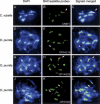Dynamic evolution at pericentromeres
- PMID: 16461884
- PMCID: PMC1415207
- DOI: 10.1101/gr.4399206
Dynamic evolution at pericentromeres
Abstract
Pericentromeres are exceptional genomic regions: in animals they contain extensive segmental duplications implicated in gene creation, and in plants they sustain rearrangements and insertions uncommon in euchromatin. To examine the mechanisms and patterns of plant pericentromere evolution, we compared pericentromere sequence from four Brassicaceae species separated by <15 million years (Myr). This flowering plant family is ideal for studying relationships between genome reorganization and pericentromere evolution-its members have undergone recent polyploidization and hybridization, with close relatives changing in genome size and chromosome number. Through sequence and hybridization analyses, we examined regions from Arabidopsis arenosa, Capsella rubella, and Olimarabidopsis pumila that are homologous to Arabidopsis thaliana pericentromeres (peri-CENs) III and V, and used FISH to demonstrate they have been maintained near centromere satellite arrays in each species. Sequence analysis revealed a set of highly conserved genes, yet we discovered substantial differences in intergenic length and species-specific changes in sequence content and gene density. We discovered that A. thaliana has undergone recent, significant expansions within its pericentromeres, in some cases measuring hundreds of kilobases; these findings are in marked contrast to euchromatic segments in these species that exhibit only minor length changes. While plant pericentromeres do contain some duplications, we did not find evidence of extensive segmental duplications, as has been documented in primates. Our data support a model in which plant pericentromeres may experience selective pressures distinct from euchromatin, tolerating rapid, dynamic changes in structure and sequence content, including large insertions of mobile elements, 5S rDNA arrays and pseudogenes.
Figures



References
-
- Acarkan, A., Rossberg, M., Koch, M., and Schmidt, R. 2000. Comparative genome analysis reveals extensive conservation of genome organisation for Arabidopsis thaliana and Capsella rubella. Plant J. 23 55–62. - PubMed
-
- Altschul, S.F., Gish, W., Miller, W., Myers, E.W., and Lipman, D.J. 1990. Basic local alignment search tool. J. Mol. Biol. 215 403–410. - PubMed
-
- Amor, D.J., Kalitsis, P., Sumer, H., and Choo, K.H. 2004. Building the centromere: From foundation proteins to 3D organization. Trends Cell Biol. 14 359–368. - PubMed
-
- Barry, A.E., Howman, E.V., Cancilla, M.R., Saffery, R., and Choo, K.H. 1999. Sequence analysis of an 80 kb human neocentromere. Hum. Mol. Genet. 8 217–227. - PubMed
-
- Begun, D.J. and Aquadro, C.F. 1992. Levels of naturally occurring DNA polymorphism correlate with recombination rates in D. melanogaster. Nature 356 519–520. - PubMed
Publication types
MeSH terms
Substances
Associated data
- Actions
- Actions
- Actions
LinkOut - more resources
Full Text Sources
Molecular Biology Databases
